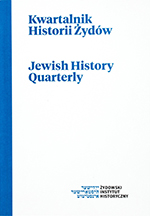Reception of the Polish-Jewish Refugees by Sweden from 1968 onwards
Reception of the Polish-Jewish Refugees by Sweden from 1968 onwards
Author(s): Jan Axel StoltzSubject(s): Political history, Social history, History of Judaism, History of Antisemitism
Published by: Żydowski Instytut Historyczny
Keywords: Polish Jewish immigration; Polish Jews; refugees; 1951 Geneva Convention; reception center; Swedish language education; employment counsellor; professional qualifications, occupational mobility
Summary/Abstract: The Polish Jews’ post-March ’68 immigration to Sweden reached its peak in 1969-1970. Nearly 3,000 Polish Jews immigrated to Sweden from 1968 to 1975. The Geneva Convention from 1951 and the Protocol from 1967 about Refugees was the legal basis. The Polish Jews were refugees in accordance with the Convention´s definition. Two generations dominated, the younger, 15 - 25 of age, and their parents´ generation, aged 45 - 60. The reasons for choosing Sweden were the Swedish welfare system, the possibilities to get an education and a good job, also Sweden´s geographical proximity to Poland.The reception of the refugees was handled by the national, governmental Labor Market Board (Swedish abbreviation AMS), which set up a dozen temporary reception centers with the task of preparing the refugee for a life after the center. The Most important was Swedish language education, also two interviews, one to replace the Polish travel document with Swedish documents, the other to be basis for the employment counsellor´s task finding work or other occupation. After closing of the temporary reception centers the refugee was referred to the local Labour Market Board for support. Around 400 Polish Jews, chiefly students, settled in the university town of Lund. They were offered an intensive Swedish language course and also a course in English for Polish students not knowing English. AMS found itself in a new situation with a big group of highly educated people with very specific qualifications that needed more language training. Also Polish professional qualifications and Swedish professional qualifications did not match. For craftsmen, however, finding a job was much easier. The concern to find adequate work also reached the Swedish Riksdag. Motions were submitted in 1971 with suggestions how to tackle the problem. The motions were referred to the Parliamentary Interior Committee for statement before decision. However, neither the Interior Committee nor later the Riksdag in plenum were ready to take action. AMS used an instrument to create individual positions called "archival work" for those with some kind of obstacle making it difficult to find a job on the open market. The elder refugees´ situation was an obstacle entitling them to do "archival work" in governmental institutions, universities, schools etc. The process of occupational mobility was largest with the highest educated. For them the first years of emigration meant an occupational degradation. The younger generation were more successful. Excellent careers in many different fields are numerous. Their successes have also become public in works by Polish authors.
Journal: Kwartalnik Historii Żydów
- Issue Year: 270/2019
- Issue No: 02
- Page Range: 433-443
- Page Count: 11
- Language: English
- Content File-PDF

